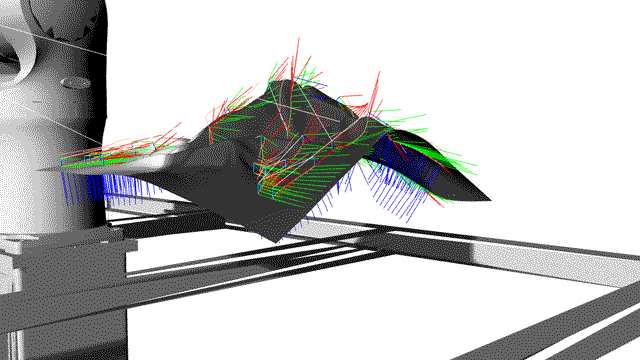Wednesday, February 19, 2014
Saturday, February 15, 2014
Project002b_SurfaceFlow: take 2 (week3)
Pink. Robovalentine!
The final product. Beauty.
Now for the process!
Step 1: Making the surface
This is cool, right?
Discovering the Heightfield from Image command. Sweeeeeeet.
Step 2: Milling the surface
No big deal.
Step 3: Paint.
Use every last drop...
Having way too much fun. Don't worry guys, it's gonna be awesome!
Curves on the surface, and offset lines.
Robotime!
Step 5: Calibration
Super focused. "wait...YEAH!!"
That awkward moment.
Deja vu.
Step 6: Gogogo

Teamwork. Always works.

Pink Makeup
Final Shot: video
A5: 40 deg
A5: -40 deg

P.S. The new and improved Sharpie Gripper tool. New features include a satisfying "click" when the Sharpie is successfully in place.
EDIT:
As much as our logo imposes a simple aesthetic, SuperMatter Tools gave us an error while we programmed it, and the error persisted even when we reduced one session to "<3 ROBO" (see below):
In the end, we programmed the logo curves in three sessions--<3 ROB, ODA, and NCE.
Saturday, February 8, 2014
Project002_SurfaceFlow (week2)
Final: making face : (
1, get a surface by patching the meshes from scanning model, then generate flows from grasshopper by Sonicflows in grasshopper
2, pick several flows that have different features
3, generate the tool path using ordered_reference under motion options
in SuperMatterTool
4, tie the pen onto the robot bit
5, teach robot the tool by calibrating it carefully
6, try calibration for the last time and luckily it works
7, locate the dimension of the model at 3 points (it doesn't turn out well and it might be better if try to draw out the edge of the surface)
8, draw onto the surface (it doesn't work out well because: a, The tool in robot settings resets to default every time it runs; b, due to the mechanism that SuperMatterTool holds, there usually is an error on No 4 anchor or No 5 anchor)
9, debugging: you need to position the A4 to run some of the failing paths
10, drawing on the surface
11, : ) vs : (
Lesson: Let's start simple, and make fun : )
12, the pengripper got finally print out...
Monday, February 3, 2014
Manufacturing the Bespoke / Yun
Reading Response:
Manufacturing the Bespoke by Bob Sheil (pages 78-87)
Sheil raises the point that robots should be and are now more integrated in the architecture design process, which leads to a question of the levels of automation--will it be a good idea to program an entire building as a single construction process? It may make economic sense to make use of a tool as frequently as possible, and it certainly seem to reduce the number of separate steps of construction. However, it is ironic that a tool--the robot--so flexible for unique building situations may precisely become a tool of mass production. People today sell generic plans and sections to land owners; in the future, people can be selling digital description files for robotic fabrication. In addition, what are then, the new roles of the architect and the builder? Will the builder become the duplicator and the architect become the space programmer?
Manufacturing the Bespoke by Bob Sheil (pages 78-87)
Sheil raises the point that robots should be and are now more integrated in the architecture design process, which leads to a question of the levels of automation--will it be a good idea to program an entire building as a single construction process? It may make economic sense to make use of a tool as frequently as possible, and it certainly seem to reduce the number of separate steps of construction. However, it is ironic that a tool--the robot--so flexible for unique building situations may precisely become a tool of mass production. People today sell generic plans and sections to land owners; in the future, people can be selling digital description files for robotic fabrication. In addition, what are then, the new roles of the architect and the builder? Will the builder become the duplicator and the architect become the space programmer?
Reading Response: Manufacturing the Bespoke (P78-P87)
By tracing back the history of robots, Bob Sheil points out that the role of robot has been shifting from predominantly regarded as advanced manufacturing and construction tools to programmable design tools, and thus their flexible potential was becoming focused at designers. Control software and physical intervention in fabrication process expands the outdated working range for robot. Thus automation is combined with an architectural culture in which design and construction are intrinsically tied to one another, and by using the robot not only as a means for automation but as a design tool, the goal is to engineer not a perfect and widely applicable fabrication process but a unique one.
My gain from this is becoming aware of the flexibility that brought by various programing applications. It also raise a question by the extreme accuracy from robot is that: taking a look at the work of laying brick as an example, I consider the random inaccuracy as a recall of human creativity, which might arose the emotional effects. I wonder if there is a day for robot programming to become complex enough to simulate such random inaccuracy? If it is, will that be a mimic or an overcome for human creative activity?
yi
Subscribe to:
Posts (Atom)




-3_new.jpg)











































